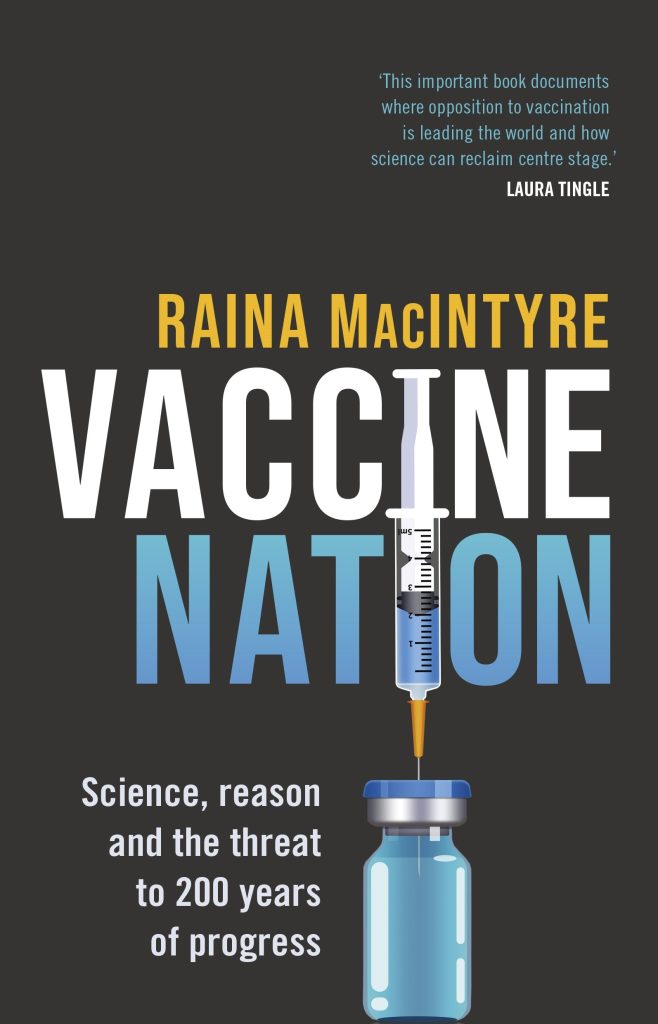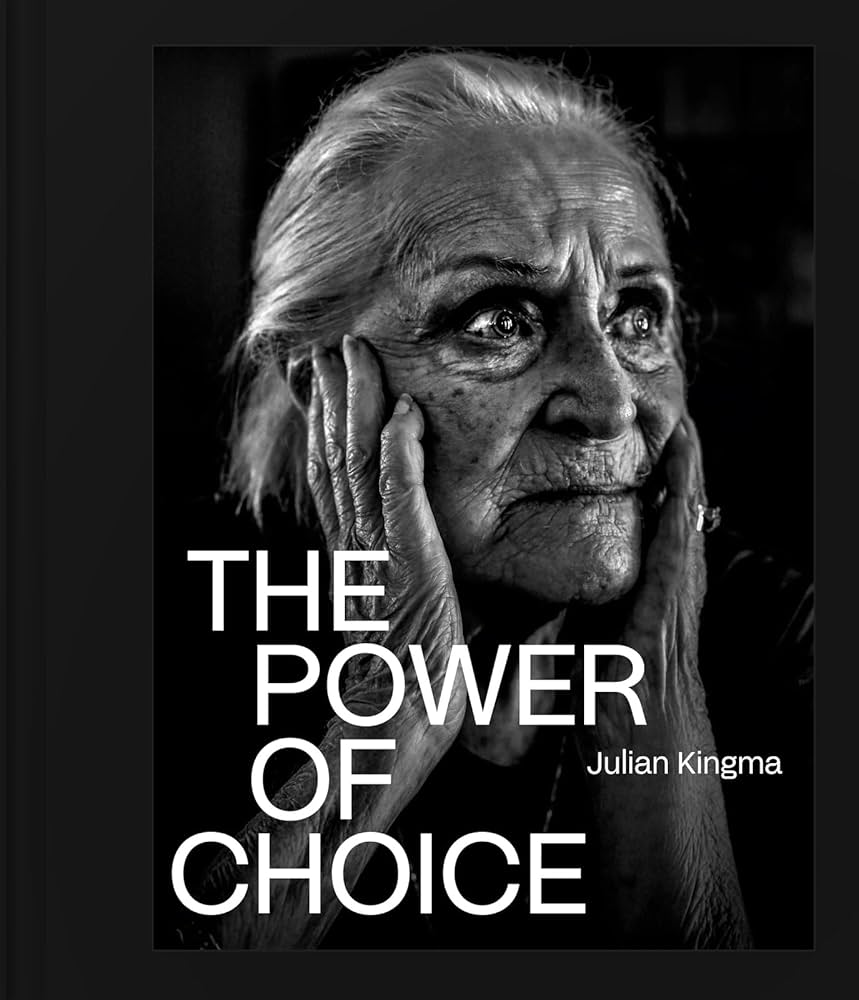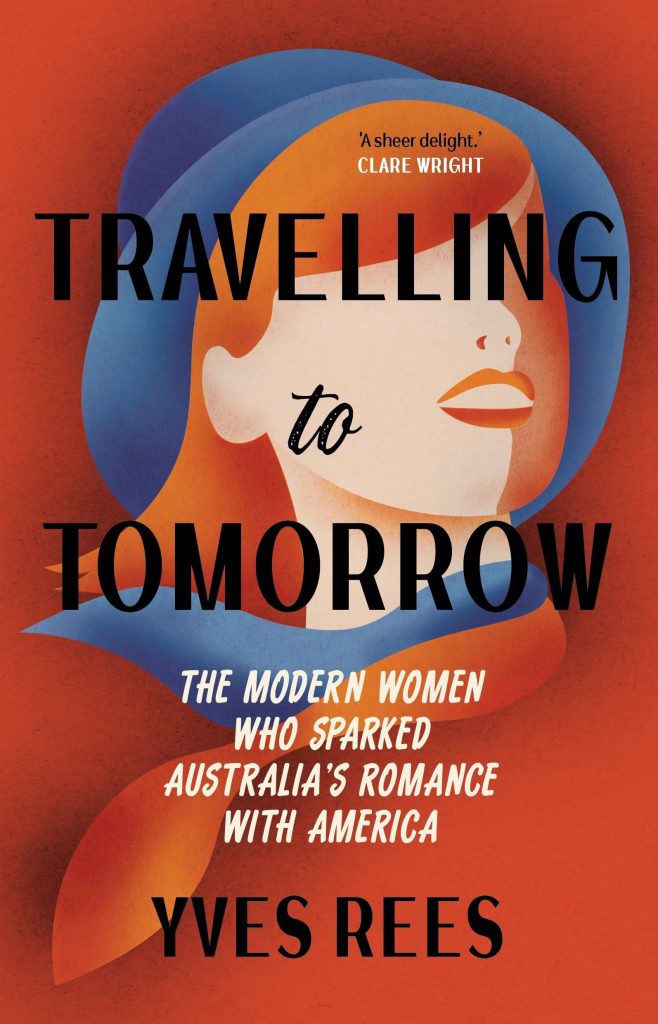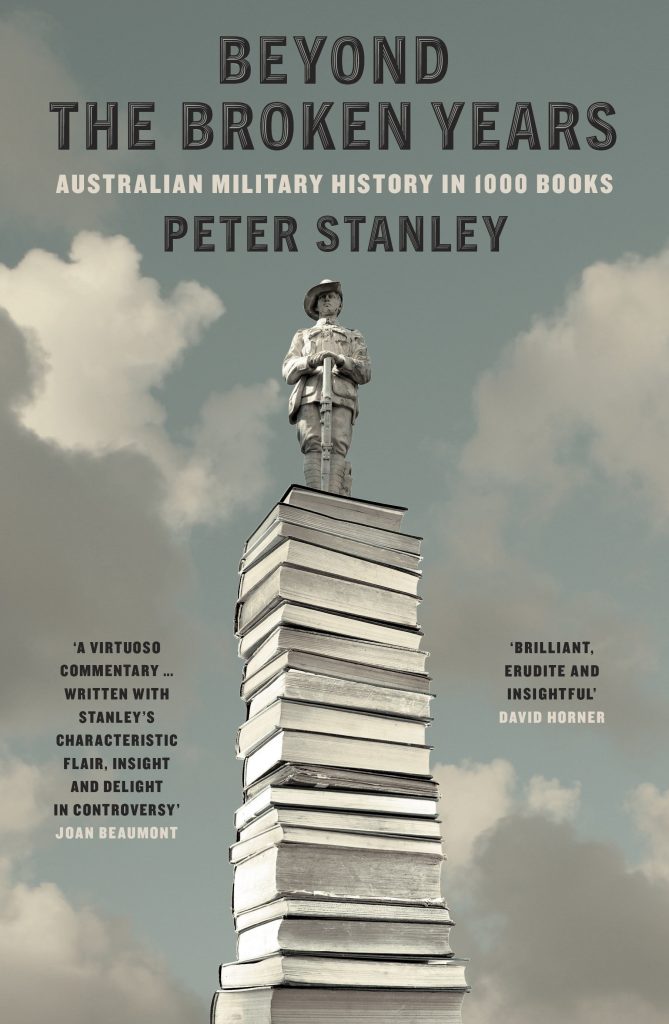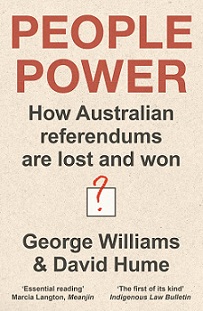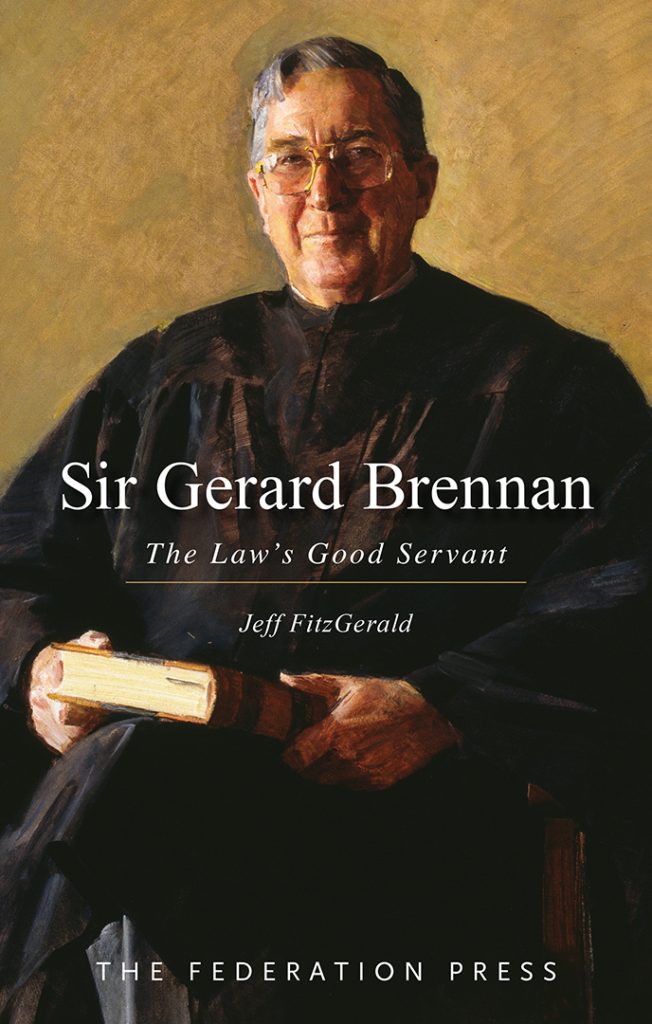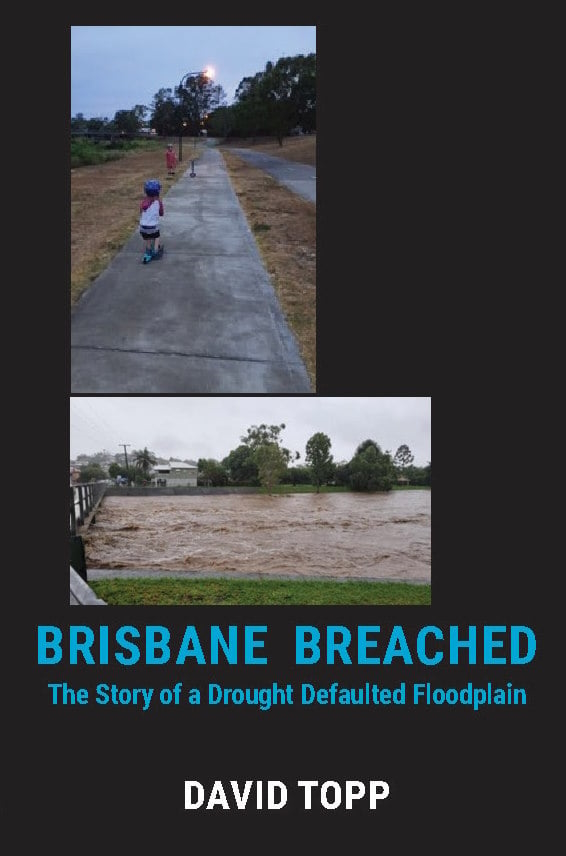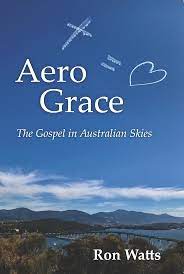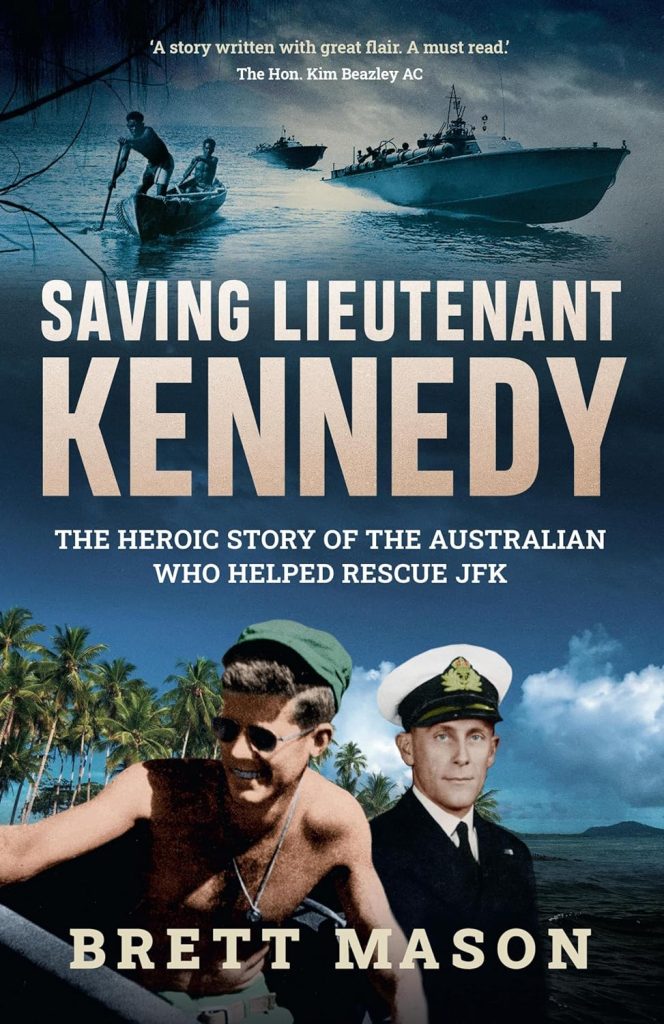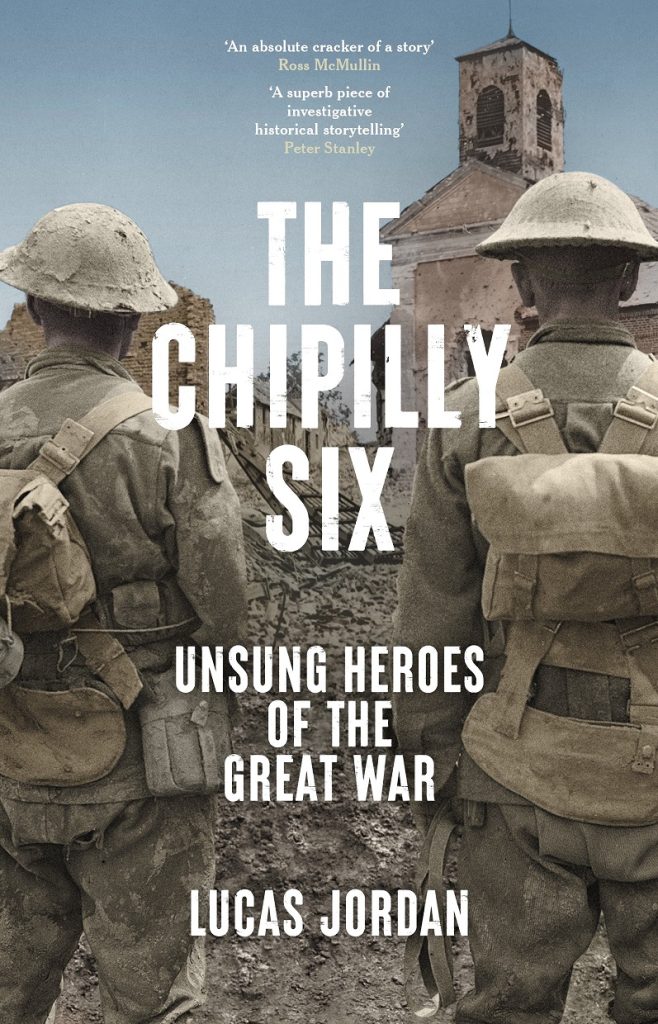Author: Professor Raina MacIntyre
Publisher: NewSouth Publishing
Reviewer: Brian Morgan
At the outset, let me say that this Vaccine Nation is a great book, written by a highly skilled doctor and academic who has what some people call, “the gift”, meaning the ability of writing in a way which is understandable to people from other vocations.
Anyone thinking of “vaccine” might be forgiven for immediately jumping to COVID but don’t forget measles, polio, smallpox, Ebola, monkey pox and tuberculosis which are but some examples of contagious diseases that require a vaccine to control or, hopefully, eliminate them. The author informs us of these as well as many other diseases that are perhaps not as well known.
Let me digress for a moment, to focus on the author. As a barrister, one sometimes finds oneself needing an expert in a field, let’s say physics. The expert may have eminent qualifications and be widely published. But does that person have the skills to translate their understanding into one which a Court or jury can also understand? Frequently, in my experience, they don’t.
This author does.
Her prose is eminently understandable. Where she uses words with which we are likely to be unfamiliar, she immediately explains them in simple terms. She does not talk just in academic words but her style of writing is such that this work was readily understandable to me and, therefore, I am sure, to other lawyers.
MacIntyre does not confine her discussion to Australia but focuses on disease outbreaks throughout the world in economically advanced countries like the United States and, on the other side of that coin, in developing countries, as well.
A little of MacIntyre’s own life’s experiences are injected (pun intended), to make a point, such as the way she has been disrespected because she was not born in Australia and her reaction when her infant son contracted a disease and she, as a mother, seems to have partly blamed herself for not having had him vaccinated. Wouldn’t we all apply the “What if” concept if it were one of our children? MacIntyre also refers to some of her own experiences together with those of adult members of her family, in a way which demonstrates that her worldview extends to real life as well as to her academic training.
MacIntyre reminds us that, in the early days of COVID, Dolly Parton gave funding towards the development of a Moderna vaccine and even adapted her well known song “Jolene” to “Vaccine” which was sung as she received her vaccine.
I received AstraZeneca as my first vaccine against Covid. Since then, I have received annual injections of Moderna. Do we know the difference between them and why the former is no longer approved in Australia? Read this book and you will quickly find out.
Do we have any idea of how much continuing research goes into even the influenza vaccine which we are encouraged to have each year?
These are just two examples of issues which the author explains plainly and simply so as to improve our understanding that a vaccine is not developed overnight; it is subjected to rigorous testing which does not cease when it is sent to the market; and how, with viruses which mutate, such as Covid and influenza, the fight to keep ahead of the latest variants of the disease, continues.
Just in case you are wondering whether to continue with Covid boosters, perhaps, the following observation might help your decision making.
MacIntyre points out that a recent study found that 5.4 percent of people in Australia are living with Covid. She goes on to point out that employers may start caring when the productivity of their employees drops due to workers being affected by Covid but regrets that so much denial and silence remains towards both the short and long term consequences of Covid. (I deliberately paraphrase her comments as my review copy of the book is a pre publication version and therefore I prefer not to appear to be quoting directly from it.)
Earlier, MacIntyre spends most of a Chapter pointing out the risks and consequences which may arise from contracting Covid. These include the misdiagnosing of conditions and, as a result, mistreating them, heart attacks and strokes. But do we ever hear of these?
And what of the anti-vaxxers? A lawyer could say, after reading this book, that, in her own quiet way, MacIntyre has systematically and clinically dissected their largely irrational rants but as I, myself, have seen, many times, when trying to dissuade an antivaxxer from a particular point of view, you would have more luck talking to a brick wall. MacIntyre, I think, seems to have had the same result where she has taken the time over the years to try to engage with such people; point out their errors with logic, demonstrated data and calmness; and got nowhere.
Whilst Vaccine Nation is not written for lawyers or by a lawyer, it is one which will readily fill in many gaps in our knowledge and understanding of diseases, disease control, topics such as “herd immunity” and vaccines. Vaccine Nation is a model for ease of understanding by people who do not have the professional training of the author. I intend to purchase a copy for my daughter and for each of my sons and their doctor spouses.
Author: Julian Kingma with Steve Offner
Publisher: New South Books
Reviewer: Brian Morgan
This is a book which explores VAD or voluntary assisted dying as told through the eyes of a number of terminally ill people who chose this means of ending their lives.
Upon turning over the front cover, I was presented with an article by Andrew Denton, a person whom I have never met but for whom I have had a high regard since his days conducting interesting and intelligent interviews on ABC television. Later, he has, I believe, become a euthanasia advocate which, perhaps, explains why he has made this contribution.
He wrote a 6 page article, headed “To Life”.
His article was followed by one headed, “Where is the song?” written by the Tasmanian author, Richard Flanagan, which includes a story involving VAD and his own brother in his role as a Country GP assisting the terminally ill.
Those articles open the door for ten thoughtful stories, accompanied by appropriate photographs, all concerning the struggles and thoughts of VAD candidates, their families and those involved in the medical profession with the VAD process.
The titles of these stories are: “A good death”; “The power of choice”; “Suffering”; “Clearing the hurdles”; “The carers”; “It can ask a lot”; “The guiding lights”; “How do you say goodbye?”; “The final word”; and “The last intimate thing”.
The book concludes with a short explanation of the VAD process which varies somewhat between the States; a timeline of the introduction of VAD laws in each State; a discussion of how they work; and a glossary of terms used and whom to contact.
I say this, in relation to all contributors, that each of them , in their own way, shines a specific light on the decisions made by their loved one, reveals the support offered to and by the person dying and gives us unique opportunities of seeing, almost at first hand, how VAD can bring comfort and peace in the face of imminent death of a terminally ill person terminally.
I know, at first hand, having spent much time with a friend who was terminally ill with pancreatic cancer and had no family in Australia, that they seem to give us courage, whilst we are trying to be supportive of them in their final days.
The Power of Choice displays their stories in words and in dignified and beautiful photographs.
One photograph, in particular, is worth mentioning as it demonstrated to me a patient doctor relationship somewhat different to the norm and the accompanying article explains why this is so.
Here we have a doctor removing her shoes and sitting on a lounge, next to her patient as they discuss the VAD process.
“Finding a connection is important” (Dr. Bu O’Brien agrees): “It is such an intimate thing when you are doing assessments and potentially administering the VAD medications”. (text page 91).
The photo accompanying this story shows the doctor and her patient sitting next to each other with the doctor’s arm around her patient’s shoulder.
Through The Power of Choice , we can recognise why this process is not every doctor’s cup of tea and how much it must take out of them, psychologically, but, also, how many of them are comfortable with their involvement in a process of choice, that is, the choice of the patient whether or not to die at a time and in a manner of their choosing.
I had subconsciously wondered whether everyone who was accepted for VAD went through with the whole process. Some of the stories demonstrate that many people obtained the chemicals with which to end their lives but did not use them immediately, or, I infer, at all, as having the means of doing so, in some cases, gives them the comfort to delay taking the final step. There are many references to the relief felt by some terminally ill people through knowing that they can use the chemicals, if and when they want to, once they are at hand.
There are some references to palliative care which, until VAD, was the process of permitting people to die with some degree of dignity and which remains the process of choice for many. Perhaps, some of us have been told to say goodbye to a dying friend in palliative care as he or she will not be with us in the morning to find that the person has, indeed, died overnight.
This is a wonderfully illuminating picture and word exposure of voluntary assisted dying, the process; why some people with terminal illnesses choose to use it; the involvement of family and loved ones in supporting the decision; and the extent to which close friends, spouses, etc, come to accept the decision to take the opportunity to die with one’s loved ones by their side.
This is a most thoughtful and appropriately named book.
Author: Yves Rees
Publisher: NSW Publishing, University of NSW Press Ltd
Reviewer: Brian Morgan
The title of this book immediately appealed to me.
I entered the Law in the days of Elizabeth Evatt and Roma Mitchell, both of whom I am proud to say I met on a number of occasions. At law school, there was a young woman in our group who outshone everyone in the class, male or female, and went on to be a Professor of Law, a celebrated author of legal texts and a State Governor whilst remaining at home!
This book shines a light on the following women all of whom found fame and fortune by leaving Australia, at least for a while.
May Lahey (law), Rose Cumming (decorator), Isabel Letham (surf pioneer and swimming teacher), Dorothy Cottrell (novelist and story writer), Mary Cecil Allen (painter and decorator), Vera Bradford (concert pianist and music teacher), Persia Campbell (academic and consumer activist), Alice Caporn (nudist and health entrepreneur), Dorothy Waugh, (academic and feminist) and Cynthia Reed (nursing student and novelist).
I doubt that anyone reading Travelling to Tomorrow (“Travelling”) could avoid being affected by the various stories. In the 1920’s, it seems clear that the United States was far more liberated, in respecting women as the equal of men, than Australia. As an aside, when my sister was studying to become a specialist physician, she was actively treated by the males in that field as a second rate person, not suited to her specialty. She managed to show otherwise.
I will refer in a little detail to one of the subjects of Travelling, Isabel Letham. Letham was lifted onto what today we would call a long board at Sydney’s Freshwater Beach by a visiting Hawaiian Olympian. Surfing at that time was new to Australia. Soon she turned to the United States to further a career in surfing and swimming.
In time, she turned to swimming, alone, as a means of income as there was no money in surfing. Ultimately, she was employed by the University of Berkeley. She taught probably thousands to swim and made her home in San Francisco. But, in late 1926, she returned to Australia to be greeted by the Press but shunned by the surf lifesaving community as “we do not teach ladies the work”.
Obviously, Australia was still way behind the United States.
All the subjects of Travelling had complex, demanding and interesting lives and this book presents them in great detail. Just think, the first Australian woman judge was appointed in the United States.
Travelling refers to places the subject of the text by their Indigenous names. While educational, I found it a little distracting and led to an excessive dependence on my part upon Dr Wikipedia. While I appreciate the education I, thereby, received, an internal glossary of place names might also have been helpful.
Dr Rees refers to having low level terror of entering a Country that had passed 86 anti-trans bills that year alone.[1] While I was not sure that this statement added to the book, perhaps, it reflects how the tables have been turned over the last one hundred years between what was then an intolerant Australia compared to a then tolerant United States.
Travelling really captures the divide between Australian working women and, in particular, those in the United States, 100 years ago. To many, perhaps, the perfect dream was to travel to the United Kingdom but many of our most successful pioneers made their names, if not their fortunes, in America.
[1] See All About Yves: Notes from a Transition (Allen & Unwin, 2021) and Nothing to Hide: Voices of Trans and Gender Diverse Australia (Allen & Unwin, 2022).
Author: Peter Stanley
Publisher: NewSouth Publishing
Reviewer: Brian Morgan
The rear cover of Beyond the Broken Years describes the author as [a] “provocative military historian”, a description that I find quite apt, having studied this fascinating book.
Let me ask you a rhetorical question. As a lawyer looking for probative evidence, would you prefer to rely on a contemporary document or an elderly witness’s memory? I suggest that the answer is obvious to us as our legal research on facts must focus on the best evidence. We, as lawyers, well know how memories can fade or be distorted by time. At page 24 of Beyond the Broken Years, the author comments on the differences between true historians and what some call “storians”. In the latter, a novel is made to appear to be based on history so as to attract the reader’s attention. While the claim may achieve its purpose, its validity does not withstand detailed investigation.
Under the heading, “Blood on the Wattle”, the author raises the question as to whether the deaths by white violence of First Nations People could or should be considered as part of a war. When one realizes that estimates of such deaths run to between 40,000 and 60,000 over a century of conflict, perhaps, we should think of these events in the context of an Australian War.
There is much to question in so many of the books that I have read over the years where I have wondered whether I was really reading something historically accurate or whether the author had prevented the facts from getting in the way of a good story.
Allow me to refer to my family’s history. My mother was born in 1917. Her mother had remarried after the death of her first husband and my mother was a product of the second relationship. What I only discovered, well after she had died, was that I had two uncles who fought at Gallipoli, one of them dying on day 1. My mother never ever mentioned a half brother, much less two, nor the fact that one had been killed. The official record of service of those two uncles is the basis of my belief. But, as well, I have copies of correspondence from my grandfather seeking the return of my deceased uncle’s personal effects and payment of the wages due to his son.
My father-in-law was a fighter pilot who flew Spitfires, Kittyhawks and Mustangs in the RAAF in WW 2. Did he ever engage in dog fights with the Japanese? According to him, the closest he got was to see several fighters disappearing in the distance. His logbook, which we only found after his death, told a different story. Methinks that the logbook is more likely to be accurate.
I thought I was reasonably well read of books dealing with Australian military history from the Boer War to the two World Wars, Korea, Vietnam and Afghanistan. Over the years, I have reviewed many such books.
What this author has done is to differentiate among true historical publications, those purporting to be such but lacking the vigour of substantial research and those written by “storians”. His knowledge of the numerous books is quite outstanding, as is the degree of his recognition of their core historical accuracy or inaccuracy. And he pulls no punches, nor, I suggest, should he.
A chapter entitled HMAS Australia refers, at pps 154-5, to the many publications (“almost an entire compactus bay”) surrounding the loss of HMAS Sydney to the actions of the Kormoran. The author is right, I suggest, to call out that another historical author had established “that the official account was ‘inadequate’ and (sic) contested ‘persistent rumours or distortions’ including one which suggested that Sydney was sunk by a Japanese submarine when records of those submarines’ locations “merely fanned further speculation”. We now know from the research by David Mearns: (The sinking of HMAS Sydney. How Australia’s greatest maritime mystery was solved), previously reviewed by me in this publication, where and how they were sunk.
As you would expect of a person summarizing Australia’s military history, publications concerning the army, navy and airforce, Vietnam, East Timor, Afghanistan. Etc, all receive his attention. I was surprised to find that, even today, there has been far less written about the RAAF than the RAN.
What does this book tell us? First, it emphasizes the gulf between true, detailed and analytical historical research, material relying on unreliable and unsubstantiated records and publications dressed up as historical accounts in a way that attracts a gullible audience to read the books or watch the films believing them to be accurate. Second, it gives us a thumbnail sketch of the hundreds of publications and in doing so demonstrates many areas that have not received much if any historical research. In addition, it invites some previous conclusions to be given additional attention!
This is an unusual book but it compels concentrated attention. I found myself left with lingering questions about some of the “historical” facts which most of us take for granted about Australia’s involvement in war.
Authors: George Williams and David Hume
Publisher: NewSouth Publishing
Reviewed by Brian Morgan
I was surprised to find out how many referendums I had voted in since being added to the electors’ roll. By my count, there have been 45 since 1900 in 20 polls and I have voted in 8 of that 20.
In that period of time, quite obviously, we have gone from communications’ infancy to the digital age. Imagine, if you can, a newspaper today, writing in these terms:
“Last night’s protracted sitting thoroughly demoralised the House of Representatives. A handful of Opposition members, a little knot of Labour members, and one or two ministerialists, maintained the semblance of a deliberative assembly, whilst the other members whose physical presence was necessary for the maintenance of a quorum, bandaged their eyes as protection against the electric light, and slept away the time on the benches” (Text page 146-7).
The authors take us through a history of referendums in Australia, those that voted “yes” and those which voted “no”, with detailed explanations for the results.
One point in particular stood out because it was clear to me that it has become more frequent as time has passed. That is, “Truth is one of the first casualties in any referendum campaign … Referendums are often characterised by a heavy reliance on material that is demonstrably false”. (Text page 295).
The authors give us a deep insight into the more recent referendums but, for now, I will confine my comments to “the Voice” referendum of 2023 as it should be fresh in all of our minds.
The amount of money poured into this referendum has been assessed by the Australian Electoral Commission at more than $336,600,000. Just think what we got for this massive expenditure. That sum alone is the cost of the referendum including over $M10 to produce the yes/no pamphlet, $M12 for the NIAA and the Museum of Australian Democracy for neutral public civics education and awareness activities, $M10.5 to the Department of Health and Aged Care to increase mental health supports for First Nations people during the period of the referendum and $M5.5 to the National Indigenous Australians Agency for consultation, policy and delivery connected to holding the referendum.
The 1999 referendum by way of example, cost $M66.
We probably remember that the 1999 Referendum focussed on the proposal for Australia to become a Republic. . The investigation by the authors of the respective sides of this debate is almost amusing in hindsight. For instance, one advertisement in November 1999, said, “This Republic: Don’t risk it … If you want to vote for the President, Vote NO to the Politician’s Republic”.
On the other hand, the proponents of the “yes” vote argued that Australia’s relations with its neighbours were being impaired by its continuing ties to the monarchy.
And you may recall there was not even a consensus prior to the Referendum as to which type of republic was better. The “no“ vote took advantage of this by comments such as “the Politician’s Republic” referring to whether the President would be appointed and dismissed by the Parliament or the people.
There is an extensive appraisal of the 2023 Referendum. Let me ask you this simple question: “Can you describe in a few sentences the detail of what was proposed in last year’s referendum?” I have tried this question on a number of people whilst preparing this review. Virtually nobody gives an identical answer and most answers don’t agree with my answer. One person had been heavily involved in promoting the “yes” vote, working with a Teal member of the House of Representatives. Her understanding of “the Voice” bore little relationship to what the Prime Minister said.
Perhaps, to explain this, if, for no other reason, reading this book is particularly useful. I think it demonstrates that, even now, Governments continue to make the mistakes that they should have identified in prior referendums, mistakes such as not explaining in simple and coherent terms, what is intended. This referendum was not the first time, for instance, that the Parliament proposed to retain a role in determining the manner in which a successful referendum would be implemented.
I suspect that most of us would feel uncomfortable in suggesting to a jury that, if they found our client guilty, they may determine what punishment should be meted out without any guidance from us. Similarly, prospective voters could well be uncomfortable in giving the Parliament a power over which we, the voters, have no say in how the vote or votes given for change will be carried out.
Summary: I suppose it is obvious to readers that I remain deeply interested in the law, and the laws. Australian Constitutional Law was a favourite subject of mine as an undergraduate, nearly 60 years ago. This book has provided a great insight into the provisions of the Commonwealth legislation which control referendums, why so many have failed, suggestions by the authors as to what should change in that process and why, as well as thought provoking comments from which we leave the book with a host of questions over which to ponder.
This is a really useful insight into referendums in Australia and, if you have the slightest interest in the process, I encourage you to read and digest this first rate book.
Author: Jeff Fitzgerald
Publisher: The Federation Press
Reviewer: Brian Morgan
Hard Cover 505 pages.
What an honour I have been given to review this book. What an insight it provides to one of our greatest lawyers of the last fifty years. The author’s note at its commencement is, in itself, revealing as it paints a picture of what Sir Gerard wanted and didn’t want, including his reluctance to have a biography written about him and a desire that his personal life remain private.
Fortunately for the reader, it soon became evident that the book could not be written without referring to Sir Gerard’s family and understanding his relationship with them. In particular, his wife, Pat, like so many lawyers’ wives, basically, ran the family during the frequent and prolonged absences of her husband caused, inter alia, by the requirement that he spend substantial periods of time away from Queensland, where his home was at that time. But as is evident from the book, Pat’s contribution to Sir Gerard and their family went far beyond that. Pat was truly Sir Gerard’s partner in life. They became, if anything, closer, as Pat’s health deteriorated leading to Sir Gerard assuming many of the domestic tasks that she had previously done.
I want to digress from the text for a moment and make a plea to all young people who are at the Bar or considering life at the Bar to read this book as a means of opening their eyes to what a barrister’s life really entails. I well remember interviewing prospective candidates to be my reader. On one occasion, a young man entered my Chambers and handed me a list of his requirements, which included working hours of 9.30am until no later than 5.30, no night work, no weekend work, six weeks vacation, each year, and an income well beyond that which a young barrister might expect to earn during his training. I stood up and offered him my seat explaining that terms such as this suggested he should be the master and I the underling. He never completed his training for the bar and, as far as I can determine, never entered practice. And, did I mention that he demanded one afternoon off per week to play sport?
The book being reviewed shines a light on the only way, of which I am aware, to succeed at the bar, namely, to work long hours, be prepared to be overworked, be respectful to the Courts and your colleagues and fully prepare your work.
I did not know that Sir Gerard’s father had been a Supreme Court Justice in Queensland. Nor did I know that Sir Gerard was, initially, refused Admission to the Bar by the Chief Justice due to a technicality on which no one wished to rely, except the Chief Justice. Another counsel at the bar table removed his wig and spoke loudly enough to be heard, suggesting that Sir Gerard was being punished for the “sins of the father” who had not been overly popular with the bar or, for that matter, with some of the Judges in Queensland. The decision to refuse his admission was quickly reversed due to the intervention of one of the other judges sitting on the Admissions Applications.
Sir Gerard was a highly intelligent and a lateral thinker and, as one sees many times throughout the book, he had the uncanny ability to re-consider older and long accepted cases, to dismantle them into fundamentals and replace them with a conclusion that has since stood the test of time.
But, although the book purports to focus on Sir Gerard, it presents far more than that. The relationship between Sir Gerard and various High Court justices over the years matured to permit genuine friendships to develop even while frequent deep disagreements concerning legal principles arose in their judicial work. It is to the credit of each person involved that such differences on principle did not interfere with the mutual respect of the justices for each other.
Sir Gerard was, whether on the Bench or in his private life, a down to earth person. He valued his family, his Church (he was a Catholic), First Nations people, the practice of the law and the importance of getting things right.
He found time to be a volunteer for the St. Vincent de Paul Society and, with his wife, would distribute fruit and vegetables to the needy on a Sunday night, introducing himself as “Gerry from St. Vincent de Paul”. It may have been a sign of the times that eyebrows were raised when Sir Gerard was observed sitting talking to First Nations people. The reality of Sir Gerard Brennan, however, was that he treated all people equally.
I particularly enjoyed the short outlines of the personalities of other justices who sat with Brennan as I knew some of them sufficiently well to have one pull up at a red light in a car bearing an L plate, one Sunday morning and, from the passenger seat, give me a very obvious greeting and another who told me that they could always tell when pleadings had been settled by me, from the first page, as they were too voluminous! I also managed to have a heated but not unfriendly discussion on a legal topic with Michael Kirby during a legal convention in Adelaide in the mid 70’s.
Sir Gerard emerges from the pages of the book as remaining a humble man, to his final days.
This book makes for riveting reading by anyone, lawyer or otherwise, who seeks to better understand the workings of the High Court of Australia.
I will conclude this review by quoting the comment of another great Queensland lawyer, now former Chief Justice of the High Court, Susan Kiefel, who said that Brennan regarded:
“The absence of unjustified discrimination, the peaceful possession of one’s property, the benefit of natural justice, and immunity from retrospective and unreasonable operation of laws” as of critical importance … he saw them as values which served to explicate and illuminate the common law, tempered by the need for the law to develop incrementally and in accordance with precedent, the judicial method and the separation of powers. Unprincipled judicial discretion was anathema to him. What was necessary was consistency and predictability”. [2022] HCATrans 135, cited at page 483 of the text.
Author: David Topp[1]
Publisher: Connor Court Publishing
Reviewer: Brian Morgan
I read this book whilst looking for reasons to work inside as we have had unrelenting rain since January. As I start this review, we have had 43mm today.
Thus, one readily recognises that our weather appears to be changing, changing for more frequent flooding episodes.
This book is not so much a story but a study of the two most recent severe rain periods that we have endured in the Brisbane area, 2011 and 2022.
I vividly recall experiencing the aftermath of the 1960 floods in Tasmania. As a teenager, I thought it was ironic that my father had to row our dinghy down one of Hobart’s main streets because my brother was marooned at his work. These days, I suspect we are all able to conjure up similar visions from television news, if not firsthand, including people on jet skis, in tinnies and so on, boating in “streets” of water.
I also visited Katherine in the Northern Territory, not long after their big flood, when the motel we had booked was free of water but not ready for occupation. The owners gleefully pointed out the high water mark for us which was above our heads.
This book is a well constructed analysis of a number of issues relating to the propensity for Brisbane to experience flooding. I will only mention some of these in the interests of brevity.
No such study would be complete without looking at the history of why Brisbane was settled where it was.
Then we would wonder about the consequences of that decision.
Anyone affected by flooding would, by now, have had endless correspondence with their household insurers, builders, Councils, their banks and, possibly, experts in flood mitigation for advice as to steps that could reduce their risk in the future.
The buyback scheme has been of immense benefit to some homeowners but not to others. As well, what of those who rebuilt after 2011 only to suffer similar damage within 10 years?
A curious bystander might wonder at the litigation that occurred over the 2011 floods and might ask the question of whether or not it was worth it, when the successful plaintiffs only received a very small sum compared to what they had claimed, and many claimants did not succeed at all.
That same curious bystander might ask about the future. Are there suburbs in Brisbane that will never be suitable for housing, despite the housing shortage? Where are all the much vaunted new houses going to be built?
The by now very curious bystander would be wondering about the significance of the Somerset and Wivenhoe dams and even wondering whether any new dams should be built and, if so, where.
I raise these dot points, so to speak, because the author eloquently considers them and largely allows readers to form their own conclusions.
His book has some excellent illustrations, mostly by photograph. But could I suggest that, in future editions, he uses a footnote immediately beneath these as sometimes finding their relevance is not easy because the explanation is located a page or more away from the photograph, forcing the reader to read backwards and forwards.
Finally, by way of an unintended segue, the reader’s understanding of this book will be greatly enhanced by the many footnotes, which I found particularly helpful.
Reading this book, one will readily appreciate that, for many of us, these floods mean more than just a talking point. They have been and, possibly, still are a cause of great hardship.
We may all wonder at the future. The effects of Climate Change and what, if anything, we in the South of Queensland can do to minimise the risk of future flooding events.
Professionally, I was involved in a number of flood claims and heard the chilling stories of hardship, suicides, feelings of helplessness, etc, felt by people who felt they had no home and no future. If this study can help to identify solutions, as I think it does, then the author has succeeded in his aims.
[1] David is a Queensland barrister and a contributor of book reviews to Hearsay: see https://www.hearsay.org.au/author/david-topp/.
Author: Ron Watts
Publisher: MAF Australia, New South Wales (2023)
Reviewer: Brian Morgan
Every once in a while, we read a book which has a profound influence on us. That influence will differ from person to person.
Aero Grace could be regarded as an important historical record of the hazards encountered by the pioneers of Outback flying in Australia. But that is only a small part of its appeal. We all know what John Flynn and Alf Traeger did with primitive aircraft and pedal powered radio sets in bringing medical help over the air and, if need be, with aircraft to take a sick or injured person to hospital. But the incentive for assisting the inland, as revealed in Aero Grace, was largely based on religion as I will demonstrate, shortly.
Imagine the days when the most modern car available was a T model Ford. If one wanted to visit remote properties, then car travel was the usual means of transport. Aircraft on the surplus market were mostly ex WW 1 vintage, flimsy and very primitive devices.
1928 seems to have the point at which understanding first emerged that aircraft could reduce travel times and open up inland Australia. And, in this context, one needs to remember that, even after WW2, the most popular and available aircraft was the Tiger Moth, albeit, with a cruising speed between 70 and 80 knots and with an open cockpit so the pilot and passenger, if any, were totally exposed to the elements.
Some ministers of religion were expected to cater for a parish the size of Victoria with limited finances, often, a sceptical superior, particularly, when asked for money to purchase an aircraft or to repair it and, similarly, with cars which were forever breaking down, becoming bogged etc.
One of these pioneers used aerial photographs to sell his story 62 times in 43 churches, 27 schools, and 45 newspaper articles in the hope of raising funds to buy an aircraft. He raised 300 pounds, only. Nowhere near enough with which to buy an aircraft.
Navigation in those days was, at best, carried out with a school atlas. There are many stories told of how a pilot would fly low over a town hoping to see the name on the railway station so as to confirm his position.
And, because these pilots were flying by the seat of their pants, there were incidents where aircraft were damaged or destroyed; and pilots were killed in crash landings. Pilots became hopelessly lost but yet, over time, the available aircraft moved from vintage, worn out machines, to modern (for their time) single and twin engine models and later prop jet aircraft which brought a massive increase in speed, reliability, efficiency and functionality.
Through all of this, it was the incentive of the various religions that drove these pilots, and their fellow workers, to work for next to nothing, take enormous risks, often leave their family for many days or weeks at a time and share in the burdens occasioned by living in the Outback.
The author says, at page 43, “Responding to human need, in all its forms, is a hallmark of the Christian Church”. This is so obvious in Aero Grace where, at times, different religions worked towards a common cause; respect was obvious between ministers of different persuasions; and their ultimate focus allowed them to work in harmony for the betterment of people in the Outback.
Missionary Aviation Fellowship and the Salvation Army seem to me to have been the most forward looking organisations in setting up religious instruction via aircraft.
Whereas, of course, Flynn saw the need for medical services, these religious based organisations saw the need for remote properties to have religious instruction or even just a friendly minister call on them from time to time.
This book has a collection of photos of many of the heroes about which it is written and a great collection of the results of crashes many of which resulted in repairs with fencing wire or anything handy, as transporting a damaged aircraft back to a maintenance base was mostly impractical.
The author speaks from personal experience of working in this field. This is very obvious to the reader from the writing itself which shows empathy and reflects first-hand experience of the hardships that he and his fellow pilots had to endure even in more recent times.
These aircraft were rarely permitted to operate in Charter category so as to take paying passengers, mail etc and, as a result, the success of operations was made possible largely by donations: something which is quite astounding. Aircraft are not cheap to buy, are expensive to maintain and very expensive to repair.
This is one of the most outstanding books that I have read in a long, long time.
As anyone who has flown a Tiger Moth or flown in one will attest, it is quite amazing that so many of the early pilots survived and succeeded as well as they did. This book also manifestly demonstrates that it was not the skin colour that mattered to the missionary pilots. First Nations and white people were all treated equally. Everyone was provided with religious support when and if they wanted it.
Author: Brett Mason
Publisher: NewSouth Publishing
Reviewer: Brian Morgan
255 pages
The Heroic Story of the Australian who helped rescue JFK
One could review this book in one sentence, namely, “One of the most interesting, entertaining and well written historical stories of WW2”. I will resist that temptation although the summary is intended to bring you greater awareness of the various topics that are covered in it.
First, and most obvious, is the background to JFK’s service in the PT109 (patrol torpedo boat) and how it was rammed by a Japanese destroyer throwing the crew into the sea.
Second is the coast watcher, Reg Evans, who met Kennedy on the shore of a tiny island and assisted the future President, skipper of the boat, and his crew, sending messages that they were still alive and describing how they could be rescued with minimal danger to the rescuers from the rampant Japanese in the area.
The third is the service provided to the allies by the Coast Watchers (over 100 stations) whose principal task was to gather intelligence mainly by observation of the Japanese and how they lived in isolation, in constant fear of being discovered by the Japanese, or of being betrayed by a local inhabitant, but who managed to send radio messages of inestimable value to the authorities in many cases enabling the allies to turn a prospective defeat into victory.
The fourth, then, is how the lives of Evans, his native helpers and Kennedy came together again in later life.
The fifth is the revelation of the personality of Kennedy, who, after his boat had been rammed, kept his crew together and demonstrated great leadership, both up until their rescue and in his subsequent career, both in politics and otherwise.
There are references throughout the book to Douglas MacArthur, his time in Australia, comparisons between Australian soldiers’ military income and the far more substantial income of the American soldiers, how soldiers on leave, particularly in Brisbane, let off steam, often enough against their opposite numbers and how, whilst on leave, the two sets of soldiers were far from friendly to one another.
The sixth, and to my mind, the most interesting facet of this book is the comparison between the very outgoing Kennedy and the quiet achiever, Evans, who, for many years, allowed stories of the rescue to attribute Kennedy with being saved by a New Zealander with a totally different name (who did not actually exist, in any event).
The author demonstrates that many who have written of the Coast Watchers, in the context of Kennedy, have given little recognition to Evans even after his identity had become well known.
However, Kennedy had not forgotten him and welcomed him to the White House. On a later occasion, Kevu, one of the Melanesian locals involved in the rescue, also attended the White House, having been sponsored to the United States by a television station. It appears that Kennedy was not aware of this visit until he saw him being interviewed on television and invited him to visit the next day. Kevu’s visit caused Menzies to be kept waiting!
There are what to me are new historical incidents littered throughout this book but I will not spoil your fun by reciting any of them.
We see the type of person that Evans was, perhaps, explaining how he survived in enemy occupied territory, and continued his coast watching duties. Finally, this book demonstrates, at least to me, the strong engaging personality of Kennedy and casts light on why he was such a popular President.
I do want to finish this review by complimenting the author. His book is entertaining, enlightening, captivating ( I stayed up late to finish it) and I think, finally, gives proper recognition to the Coast Watchers of the Solomon and the other Pacific islands of the vital and dangerous but highly important role they played in the defeat of the Japanese.
Author: Lucas Jordan
Publisher: NewSouth Publishing
Reviewer: Brian Morgan
It seems, these days, that, just when we have our recent history sorted, we find that we are missing some important pieces.
This book reveals one such piece.
Don’t be confused by the name which presents as a teaser to the stories which the book reveals.
Imagine a hill which overlooks the Somme River and has, therefore, great strategic importance in the latter days of World War 1.
Then, overlay several thousand British troops trying, unsuccessfully, to capture it, and suffering frightful losses in the attempt.
Then, along come 6 Australians who might be described by the uninitiated as undisciplined larrikins.
Rather than pursuing the frontal assault which had failed so miserably, these six concentrated on the other three faces of that hill and quickly overwhelmed the German forces with no loss of Australian lives. Six Australians achieved what some thousands of British troops could not.
However their success, one might say, caused great embarrassment to the British. To assuage this, the credit for capturing the hill was given to the British and not to these six soldiers.
But this book goes beyond that battle to follow the lives of the six Australians and, perhaps more importantly, the appalling treatment they suffered on their return home when they sought compensation, medical treatment, etc for injuries caused during their time in Europe.
I suggest that anyone who reads this book may conclude that heroes who volunteered to fight and managed to return home with physical and mental injuries should not have been treated so poorly by the Repatriation authorities.
In one instance, an ongoing chest condition caused by a wounding in France was discounted, despite it having been treated in the United Kingdom and despite it having left physical signs on the body of the soldier. One might easily presume that the authorities would have had the soldier’s complete service history or could have obtained it, but alas, liability was denied for a war pension and health benefits.
None of the six gained financial security even though they were hard workers. Their inability to obtain free medical treatment and associated benefits also, largely, left them unable to obtain appropriate medical care.
Until this book was recently published, there has been complete silence as to what these six young men achieved and no explanation for why the British were applauded for taking the hill when they had nothing to do with it.
You, like me, will probably shake your head again at how poorly these six were treated by their own Country.
But their contribution to Australia extends beyond their War service, per se, as it is likely that they were responsible for commencing the dawn Service on Anzac Day when they happened upon a lady placing flowers on a memorial at dawn and thought that this event should be continued and promoted.
The six individual lives demonstrated their deep commitment to assist fellow returned soldiers as well as to provide ongoing support to the RSL as it is now known.
These six men are indeed true heroes whose success has been obscured by time and small minds.
But I think their story is more than this. It demonstrates, as we have seen in later campaigns, that our society does not sufficiently appreciate the sacrifice made by those who fought to save our Country and that the bureaucrats whose job, surely, extended to ensuring that returned soldiers were cared for, in mind and body, failed miserably so to perform.
It is no wonder that, after all this time, we are having a Royal Commission into Defence and Veteran suicide. The stories told by this book suggest that it is many years overdue.


